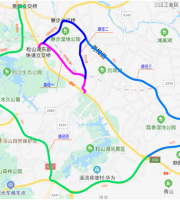Click the above constructor to follow the official account. Please open the official account home page and click three points on the upper right corner to set the official account as a star to prevent articles from being lost and receive articles from the official account as soon as possible.

Pre embedded bolt type cantilever scaffolding and ordinary I-beam cantilever scaffolding are two common types of scaffolding, each with different characteristics and application scenarios. When choosing, it is necessary to comprehensively consider the specific engineering requirements and conditions..

.
Firstly, let’s take a look at the pre embedded bolt type cantilever scaffold. This type of scaffold achieves cantilever support by pre embedding bolts on the building structure and then connecting the cantilever beam of the scaffold to the bolts. This type of scaffold has advantages such as easy installation, stable structure, and good stress performance. It is suitable for some engineering projects that require high scaffolding support and have a long construction period, such as high-rise buildings, bridges, large equipment, etc. In addition, pre embedded bolt type cantilever scaffolding can also be combined and expanded as needed to meet the needs of different projects..
.
Next, let’s take a look at ordinary I-beam cantilever scaffolding. This type of scaffold uses I-beam as the main beam and is supported by overhanging on the building structure to achieve the construction of the scaffold. It has the characteristics of simple structure, low cost, and wide applicability. Ordinary I-beam cantilever scaffolding is suitable for some engineering projects with relatively low requirements for scaffolding support and short construction cycles, such as general construction and decoration..
.
So, how to choose between pre embedded bolt type cantilever scaffolding and ordinary I-beam cantilever scaffolding? This requires comprehensive consideration based on specific engineering requirements and conditions. Here are some factors to consider when making a choice:.
.
1. Engineering requirements: Firstly, it is necessary to clarify the requirements of the project for scaffolding support, including support height, bearing capacity, stability, etc. For projects with high requirements and long construction cycles, pre embedded bolt type cantilever scaffolding can be chosen; For projects with relatively low requirements and short construction cycles, ordinary I-beam cantilever scaffolding can be chosen..
.
2. Structural characteristics: The pre embedded bolt type cantilever scaffold has the characteristics of stability and good stress performance, and is suitable for scenarios with high requirements for scaffold support; Ordinary I-beam cantilever scaffolding, on the other hand, has the characteristics of simplicity and low cost, making it suitable for scenarios with relatively low requirements for scaffolding support..
.
3. Safety: When choosing scaffolding, safety is a very important consideration. Regardless of the type of scaffold chosen, it is necessary to ensure its structural stability, safety and reliability, and regular inspections and maintenance are required during use..
.
4. Economy: When choosing scaffolding, it is also necessary to consider its economy. It is necessary to choose a scaffolding type with reasonable cost and high cost-effectiveness based on the project budget and actual situation..
.
In summary, both pre embedded bolt type cantilever scaffolding and ordinary I-beam cantilever scaffolding have their own advantages, disadvantages, and applicability. When choosing, it is necessary to comprehensively consider the specific engineering requirements and conditions, and choose the most suitable scaffolding type. Meanwhile, during use, attention should also be paid to safety, economy, and other issues to ensure the smooth progress of the project..
JGJ59-2011 Building Construction.



